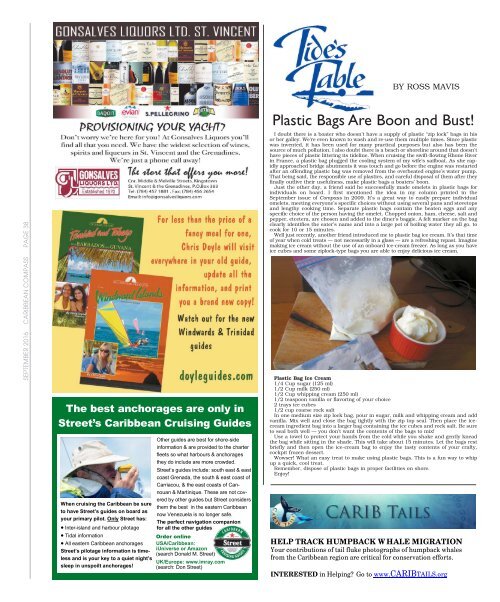Caribbean Compass Yachting Magazine September 2016
Welcome to Caribbean Compass, the most widely-read boating publication in the Caribbean! THE MOST NEWS YOU CAN USE - feature articles on cruising destinations, regattas, environment, events...
Welcome to Caribbean Compass, the most widely-read boating publication in the Caribbean! THE MOST NEWS YOU CAN USE - feature articles on cruising destinations, regattas, environment, events...
Create successful ePaper yourself
Turn your PDF publications into a flip-book with our unique Google optimized e-Paper software.
BY ROSS MAVIS<br />
SEPTEMBER <strong>2016</strong> CARIBBEAN COMPASS PAGE 38<br />
The best anchorages are only in<br />
Street’s <strong>Caribbean</strong> Cruising Guides<br />
When cruising the <strong>Caribbean</strong> be sure<br />
to have Street’s guides on board as<br />
your primary pilot. Only Street has:<br />
Inter-island and harbour pilotage<br />
Tidal information<br />
All eastern <strong>Caribbean</strong> anchorages<br />
Street’s pilotage information is timeless<br />
and is your key to a quiet night’s<br />
sleep in unspoilt anchorages!<br />
Other guides are best for shore-side<br />
information & are provided to the charter<br />
fleets so what harbours & anchorages<br />
they do include are more crowded.<br />
Street’s guides include: south east & east<br />
coast Grenada, the south & east coast of<br />
Carriacou, & the east coasts of Cannouan<br />
& Martinique. These are not covered<br />
by other guides but Street considers<br />
them the best in the eastern <strong>Caribbean</strong><br />
now Venezuela is no longer safe.<br />
The perfect navigation companion<br />
for all the other guides<br />
Order online<br />
USA/<strong>Caribbean</strong>:<br />
iUniverse or Amazon<br />
(search Donald M. Street)<br />
UK/Europe: www.imray.com<br />
(search: Don Street)<br />
Plastic Bags Are Boon and Bust!<br />
I doubt there is a boater who doesn’t have a supply of plastic “zip lock” bags in his<br />
or her galley. We’re even known to wash and re-use them multiple times. Since plastic<br />
was invented, it has been used for many practical purposes but also has been the<br />
source of much pollution. I also doubt there is a beach or shoreline around that doesn’t<br />
have pieces of plastic littering its tideline. When cruising the swift-flowing Rhone River<br />
in France, a plastic bag plugged the cooling system of my wife’s sailboat. As she rapidly<br />
approached bridge abutments it was touch and go before the engine was restarted<br />
after an offending plastic bag was removed from the overheated engine’s water pump.<br />
That being said, the responsible use of plastics, and careful disposal of them after they<br />
finally outlive their usefulness, make plastic bags a boaters’ boon.<br />
Just the other day, a friend said he successfully made omelets in plastic bags for<br />
individuals on board. I first mentioned the idea in my column printed in the<br />
<strong>September</strong> issue of <strong>Compass</strong> in 2009. It’s a great way to easily prepare individual<br />
omelets, meeting everyone’s specific choices without using several pans and stovetops<br />
and lengthy cooking time. Separate plastic bags contain the beaten eggs and any<br />
specific choice of the person having the omelet. Chopped onion, ham, cheese, salt and<br />
pepper, etcetera, are chosen and added to the diner’s baggie. A felt marker on the bag<br />
clearly identifies the eater’s name and into a large pot of boiling water they all go, to<br />
cook for 10 or 15 minutes.<br />
Well just recently, another friend introduced me to plastic bag ice cream. It’s that time<br />
of year when cold treats — not necessarily in a glass — are a refreshing repast. Imagine<br />
making ice cream without the use of an onboard ice-cream freezer. As long as you have<br />
ice cubes and some ziplock-type bags you are able to enjoy delicious ice cream.<br />
Plastic Bag Ice Cream<br />
1/4 Cup sugar (125 ml)<br />
1/2 Cup milk (250 ml)<br />
1/2 Cup whipping cream (250 ml)<br />
1/2 teaspoon vanilla or flavoring of your choice<br />
2 trays ice cubes<br />
1/2 cup coarse rock salt<br />
In one medium size zip lock bag, pour in sugar, milk and whipping cream and add<br />
vanilla. Mix well and close the bag tightly with the zip top seal. Then place the icecream<br />
ingredient bag into a larger bag containing the ice cubes and rock salt. Be sure<br />
to seal both well — you don’t want the contents of the bags to mix!<br />
Use a towel to protect your hands from the cold while you shake and gently knead<br />
the bag while sitting in the shade. This will take about 15 minutes. Let the bags rest<br />
briefly and then open the ice-cream bag to enjoy the tasty contents of your crafty,<br />
cockpit frozen dessert.<br />
Wowser! What an easy treat to make using plastic bags. This is a fun way to whip<br />
up a quick, cool treat.<br />
Remember, dispose of plastic bags in proper facilities on shore.<br />
Enjoy!<br />
HELP TRACK HUMPBACK WHALE MIGRATION<br />
Your contributions of tail fluke photographs of humpback whales<br />
from the <strong>Caribbean</strong> region are critical for conservation efforts.<br />
INTERESTED in Helping? Go to www.CARIBTAILS.org


















